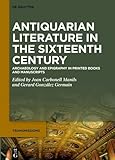Antiquarian Literature in the Sixteenth Century : Archaeology and Epigraphy in Printed Books and Manuscripts / ed. by Joan Carbonell Manils, Gerard González Germain.
Material type: TextSeries: Transmissions : Studies on conditions, processes and dynamics of textual transmission ; 10Publisher: Berlin ; Boston : De Gruyter, [2024]Copyright date: 2024Description: 1 online resource (VI, 371 p.)Content type:
TextSeries: Transmissions : Studies on conditions, processes and dynamics of textual transmission ; 10Publisher: Berlin ; Boston : De Gruyter, [2024]Copyright date: 2024Description: 1 online resource (VI, 371 p.)Content type: - 9783111344768
- 9783111350523
- 9783111349916
- 000
- online - DeGruyter
- Issued also in print.
| Item type | Current library | Call number | URL | Status | Notes | Barcode | |
|---|---|---|---|---|---|---|---|
 eBook
eBook
|
Biblioteca "Angelicum" Pont. Univ. S.Tommaso d'Aquino Nuvola online | online - DeGruyter (Browse shelf(Opens below)) | Online access | Not for loan (Accesso limitato) | Accesso per gli utenti autorizzati / Access for authorized users | (dgr)9783111349916 |
Frontmatter -- Contents -- Introduction -- Framing antiquarian debate in the sixteenth century -- What Was Antiquarian Literature in 1500? Canons and Definitions -- Dibattiti antiquari nella Roma post-tridentina. Il caso di Simon Magus o Semo Sancus (CIL VI 567) -- Antiquarian prints and their readers -- Antiquarian Literature in French Libraries: The Annotated Epigrammata Antiquae Urbis of Nîmes and Carpentras. The Hand of Martinus Smetius -- Printing, Reading and Owning Apianus and Amantius’s Inscriptiones sacrosanctae vetustatis (With a Worldwide List of Known Copies) -- Gli esemplari “vaticani” delle Inscriptiones sacrosanctae vetustatis di Apianus-Amantius -- Antonio Agustín’s Dialogos de medallas, inscriciones y otras antiguedades (1587): List of Known Copies and Owners -- Epigraphic manuscripts in the sixteenth century -- Una silloge prodotta nel circolo veronese dei Saraina: il manoscritto pseudofelicianeo Vat. lat. 5251 (ante 1534) -- Antiquae and modernae. The ms. 99 from the Universitat de Barcelona and Renaissance Miscellanies -- Le schedulae solitariae Ligorianae nei codici e stampe di epigrafia nel Cinquecento: l’esemplare degli Epigrammata antiquae Urbis (1521) di Benedetto Egio da Spoleto (Bodleian Library, ms. Auct. S. 10 25) -- Alfonso Chacón (1530–1599), Epigrapher in Portugal -- Mapping antiquarian activity -- Viaggiatori stranieri e umanisti locali: sillogi epigrafiche e descrizioni antiquarie nell’Italia meridionale -- Codici epigrafici e sillogi a stampa rinascimentali nelle biblioteche di Venezia -- La Biblioteca Vaticana nelle guide di Roma di Francesco Albertini e Andrea Fulvio -- Non solo libri. Letture, descrizioni e (ri)definizioni del panorama antiquario barcellonese tra il XV e il XVI secolo -- Index of Names -- Index of Manuscripts and Printed Copies -- Index of Inscriptions
restricted access online access with authorization star
http://purl.org/coar/access_right/c_16ec
During the sixteenth century, antiquarian studies (the study of the material past, comprising modern archaeology, epigraphy, and numismatics) rose in Europe in parallel to the technical development of the printing press. Some humanists continued to prefer the manuscript form to disseminate their findings – as numerous fair copies of sylloges and treatises attest –, but slowly the printed medium grew in popularity, with its obvious advantages but also its many challenges. As antiquarian printed works appeared, the relationship between manuscript and printed sources also became less linear: printed copies of earlier works were annotated to serve as a means of research, and printed works could be copied by hand – partially or even completely. This book explores how antiquarian literature (collections of inscriptions, treatises, letters.) developed throughout the sixteenth century, both in manuscript and in print; how both media interacted with each other, and how these printed antiquarian works were received, as attested by the manuscript annotations left by their early modern owners and readers.
Issued also in print.
Mode of access: Internet via World Wide Web.
In English.
Description based on online resource; title from PDF title page (publisher's Web site, viewed 20. Nov 2024)


